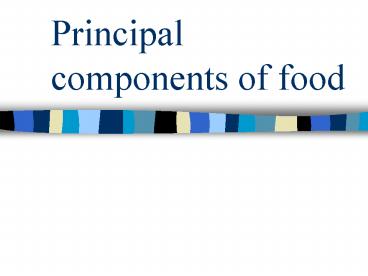Principal components of food - PowerPoint PPT Presentation
1 / 39
Title:
Principal components of food
Description:
Function maintains the structure and proper functioning of all living ... 4 chiral carbons. 24 = 16 stereoisomers. Glucose. Glucose. Open chain (acyclic form) ... – PowerPoint PPT presentation
Number of Views:129
Avg rating:3.0/5.0
Title: Principal components of food
1
Principal components of food
2
Principal components
- Proteins
- Carbohydrates
- Fats and oils
3
Proteins
- Function maintains the structure and proper
functioning of all living organisms. - Structure a polymer formed from about 20 amino
acids by peptide linkage.
4
Some amino acids
5
Peptide linkage
6
Hydrolysis of proteins
- Breaks the peptide linkages in a protein molecule
- The composition of the protein molecule may be
deduced by using paper chromatography
7
Hydrolysis of proteins
8
Past paper questions
- 2001 6c
- 2001 6d
- 2000 7b
9
Carbohydrates
- Function provide energy
- Formula Cx H2yOy
- Monosaccharides C6H12O6 (glucose, fructose)
- Disaccharide C12H22O11 (sucrose, maltose)
- Polysaccharides (C6H10O5)n (starch, cellulose)
10
Stereoisomers of C6H12O6
4 chiral carbons 24 16 stereoisomers
11
Glucose
12
Glucose
- Open chain (acyclic form)
- Two Ring forms (cyclic form)
- M.p. 146oC , 150oC
- Optical rotations
- 112o , 19o ? 52.7o
13
(No Transcript)
14
Fructose
15
Reducing sugars
16
Reducing sugars
17
Disaccharides
18
Maltose
19
Maltose
20
Sucrose
21
Polysaccharides
- Carbohydrate polymers
- Storage polysaccharides
- Energy storage starch and glycogen
- Structural polysaccharides
- Use to provide protective walls to cells -
cellulose
22
Starch
23
Cellulose
24
Hydrolysis of sucrose
- Sucrose, like all disaccharides, is hydrolysed by
dilute mineral acids to two monosaccharides,
glucose and fructose - C12H22O11 H2O ? C6H12O6 C6H12O6
- The reaction can be effected by enzyme
25
Hydrolysis of starch
- A solution of starch can be hydrolysed in the
presence of an enzyme to a disaccharide, maltose. - 2(C6H10O5)n nH2O ? nC12H22O11(maltose)
- It starch is boiled with dilute sulphuric acid,
it is hydrolyzed to a monosaccharide, glucose.
(C6H10O5)n nH2O ? nC6H12O6
26
Past paper questions
- 2001 7c
- 2000 6c
- 1998 7b
27
Fats and oils
28
Triglyceride
29
Fatty acids
30
Fatty acid
31
Fatty acid
32
Hardening of vegetable oil
- Unsaturated oils usually have a lower melting
point and exist as a liquid. - Hydrogenation of some of the CC bonds converts
to solid fats. - E.g. Margarine
33
Hydrolysis of fats and oils
- Fats and oils are hydrolysed into carboxylic acid
and glycerol in human body. - The substances are then used as fuel, or used in
building cell membranes and fatty tissues. - In laboratory, hydrolysis can be carried out in
an alkaline medium (i.e. saponification)
34
Iodine value
- Unsaturated fat is considered desirable in our
diet. - Iodine value is defined as the number of grams of
iodine that reacts with 100 grams of fats/oils.
35
Fats / Oils Fats / Oils Iodine values
Animal fats Butter 25-30
Animal fats Dripping 35-65
Animal fats Lard 45-65
Vegetable oils Coconut oil 8-10
Cotton seed oil 80-140
Ground-nut oil 85-105
Olive oil 80-90
Almond oil 90-110
Corn oil 115-130
36
Rancidity
- Rancidity is caused by reactions of fats / oils
which release foul smelling aldehydes and fatty
acids. - Two types
- Hydrolytic rancidity
- Oxidative rancidity
37
Hydrolytic rancidity
- Occurs as a result of hydrolysis of glyceride
molecules to glyerol and free carboxylic acids by
the presence of moisture in the oils. - E.g. Frying of chips in oil at high temp.
- The reaction is speeded up in the presence of
certain micro-organisms or enzymes.
38
Oxidative rancidity
- Occurs when fats/oils are exposed to air and
undergo oxidation. - Fats/oils have a high degree of unsaturation are
more susceptible to oxidation. - The oxidation is a free radical mechanism and is
accelerated by trace metals, light and free
radical initiators.
39
Past paper questions
- 2000 6a
- 1999 7d






























